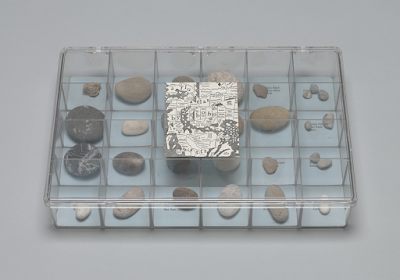Tracey Emin
Every Part of Me’s Bleeding
New York City, USA: Lehman Maupin, 1999
49.5 x 34cm
Edition size unknown
A machine-folded promotional poster from Emin's first solo exhibition in the United States, from May 1st to June 19th, 1999.
Available for $100 US, here.
"Tracey Emin was born in London in 1963 and was raised in the seaside town of Margate on the English coast. After leaving school at an early age, Emin enrolled at Maidstone College of Art in Kent at the age of 20 and studied painting. She then went to London where she completed a Masters in Painting at the Royal College of Art. Emin is a storyteller whose subject matter comes from Emin's own rich life. Emin's first one-person gallery exhibition at the White Cube titled "My Major Retrospective" included family memorabilia accompanied with each related story and also presented an archive of Emin's early paintings which she had destroyed. Her book "Exploration of the Soul" told the story of her life from her and her twin brother's conception, their birth and early life to the age of 13. She presented this collection in a series of readings during a journey across America. In 1995, Emin opened The Tracey Emin Museum in London. At the museum, Emin sat with her work and spoke with visitors to encourage an exchange of experiences.
"Every Part of Me's Bleeding" will consist of many works done in a variety of media including several large-scale sculptures, drawings, neon pieces, video and a quilt. One large-scale piece in the exhibition is a seaside beach hut from a past vacation spot of Emin's friend artist Sarah Lucas, Emin and a former boyfriend. The actual hut has been carefully taken apart and reassembled in the main gallery space. Through the poetry of her honest retelling of unique and intimate life-events Emin establishes a generous dialogue between the viewer and the artist. The personal expands to the universal in the way Emin takes a feeling about her life and forms it into a genuine expression of a human emotion."
- press release
"By Jan Avgikos
"Girl talk" never much enjoyed the primetime exposure it has long deserved until last year, when the House Judiciary Committee chose to post transcripts of Monica Lewinsky's intimate phone conversations with Linda Tripp on the Internet for all to read. I particularly liked the part where Tripp tells Lewinsky she's starting to "think like him" and then muses over how she would like to kick him in the balls until they were flat like little pancakes. It's a perfect example of the "discourse": direct, uncensored, unfettered by gentility or reserve, and, when appropriate, graphically violent. Of course, we all know you should never kick anyone in the balls (even if it seems like a good idea at the time), but the point of "girl talk" is that the speech itself is liberating, even a substitute for action when action may be impossible.
We haven't heard a lot of "girl talk" in the galleries of New York lately—but that's nothing new. Male rants, after all, are considered cultural; female rants, premenstrual. Same ol' same ol'. If it's still the case that transgressive behavior by women is dismissed as simple "acting out," you get the sense that that's just fine with Tracey Emin, an artist who revels in hysteronics— mostly in relation to love gone bad.
There's nothing particularly enlightened in Emin's talk. And yet, despite her hard-baked litany of abuses suffered and her often scatological subject matter, she has a charming way with language. In her most recent show, she marries passionate, handwritten phrases—"Every Part of Me's Bleeding"; "My Cunt is Wet with Fear"— with cool blue neon. You feel her willful occupation of Conceptual art's formal turf (think Bruce Nauman, Richard Serra, Joseph Kosuth) as well as her wicked put-down of its pompous austerity and authority. It's even better when her rapacious bombast lands on one of the most treasured of feminist-art icons, the handmade quilt. Emin trades in the flowery phrases found in ladies' heirloom handiwork for turbo-charged, Medusan rage directed at all the guys who've done her wrong. In Psycho Slut, I999, the eponymous words are (mis)spelled out (PYSCO SLUT) in big, bold lettering appliqued at the top of the quilt, as are phrases plucked from the maker's inner monologue: "I didn't know I had to ask to share your life"; "You see I'm one of the best"; "You know how much I love you."
- Jan Avgikos, Artforum, October 1999














































